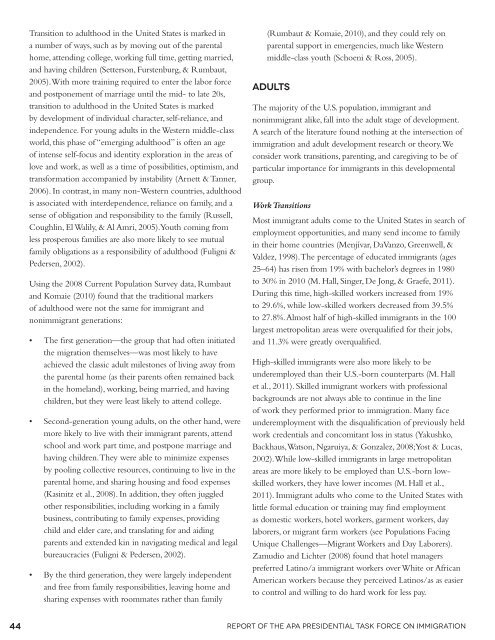Crossroads: The Psychology of Immigration in the New Century
Crossroads: The Psychology of Immigration in the New Century
Crossroads: The Psychology of Immigration in the New Century
You also want an ePaper? Increase the reach of your titles
YUMPU automatically turns print PDFs into web optimized ePapers that Google loves.
Transition to adulthood <strong>in</strong> <strong>the</strong> United States is marked <strong>in</strong><br />
a number <strong>of</strong> ways, such as by mov<strong>in</strong>g out <strong>of</strong> <strong>the</strong> parental<br />
home, attend<strong>in</strong>g college, work<strong>in</strong>g full time, gett<strong>in</strong>g married,<br />
and hav<strong>in</strong>g children (Setterson, Furstenburg, & Rumbaut,<br />
2005). With more tra<strong>in</strong><strong>in</strong>g required to enter <strong>the</strong> labor force<br />
and postponement <strong>of</strong> marriage until <strong>the</strong> mid- to late 20s,<br />
transition to adulthood <strong>in</strong> <strong>the</strong> United States is marked<br />
by development <strong>of</strong> <strong>in</strong>dividual character, self-reliance, and<br />
<strong>in</strong>dependence. For young adults <strong>in</strong> <strong>the</strong> Western middle-class<br />
world, this phase <strong>of</strong> “emerg<strong>in</strong>g adulthood” is <strong>of</strong>ten an age<br />
<strong>of</strong> <strong>in</strong>tense self-focus and identity exploration <strong>in</strong> <strong>the</strong> areas <strong>of</strong><br />
love and work, as well as a time <strong>of</strong> possibilities, optimism, and<br />
transformation accompanied by <strong>in</strong>stability (Arnett & Tanner,<br />
2006). In contrast, <strong>in</strong> many non-Western countries, adulthood<br />
is associated with <strong>in</strong>terdependence, reliance on family, and a<br />
sense <strong>of</strong> obligation and responsibility to <strong>the</strong> family (Russell,<br />
Coughl<strong>in</strong>, El Walily, & Al Amri, 2005). Youth com<strong>in</strong>g from<br />
less prosperous families are also more likely to see mutual<br />
family obligations as a responsibility <strong>of</strong> adulthood (Fuligni &<br />
Pedersen, 2002).<br />
Us<strong>in</strong>g <strong>the</strong> 2008 Current Population Survey data, Rumbaut<br />
and Komaie (2010) found that <strong>the</strong> traditional markers<br />
<strong>of</strong> adulthood were not <strong>the</strong> same for immigrant and<br />
nonimmigrant generations:<br />
• <strong>The</strong> first generation—<strong>the</strong> group that had <strong>of</strong>ten <strong>in</strong>itiated<br />
<strong>the</strong> migration <strong>the</strong>mselves—was most likely to have<br />
achieved <strong>the</strong> classic adult milestones <strong>of</strong> liv<strong>in</strong>g away from<br />
<strong>the</strong> parental home (as <strong>the</strong>ir parents <strong>of</strong>ten rema<strong>in</strong>ed back<br />
<strong>in</strong> <strong>the</strong> homeland), work<strong>in</strong>g, be<strong>in</strong>g married, and hav<strong>in</strong>g<br />
children, but <strong>the</strong>y were least likely to attend college.<br />
• Second-generation young adults, on <strong>the</strong> o<strong>the</strong>r hand, were<br />
more likely to live with <strong>the</strong>ir immigrant parents, attend<br />
school and work part time, and postpone marriage and<br />
hav<strong>in</strong>g children. <strong>The</strong>y were able to m<strong>in</strong>imize expenses<br />
by pool<strong>in</strong>g collective resources, cont<strong>in</strong>u<strong>in</strong>g to live <strong>in</strong> <strong>the</strong><br />
parental home, and shar<strong>in</strong>g hous<strong>in</strong>g and food expenses<br />
(Kas<strong>in</strong>itz et al., 2008). In addition, <strong>the</strong>y <strong>of</strong>ten juggled<br />
o<strong>the</strong>r responsibilities, <strong>in</strong>clud<strong>in</strong>g work<strong>in</strong>g <strong>in</strong> a family<br />
bus<strong>in</strong>ess, contribut<strong>in</strong>g to family expenses, provid<strong>in</strong>g<br />
child and elder care, and translat<strong>in</strong>g for and aid<strong>in</strong>g<br />
parents and extended k<strong>in</strong> <strong>in</strong> navigat<strong>in</strong>g medical and legal<br />
bureaucracies (Fuligni & Pedersen, 2002).<br />
• By <strong>the</strong> third generation, <strong>the</strong>y were largely <strong>in</strong>dependent<br />
and free from family responsibilities, leav<strong>in</strong>g home and<br />
shar<strong>in</strong>g expenses with roommates ra<strong>the</strong>r than family<br />
(Rumbaut & Komaie, 2010), and <strong>the</strong>y could rely on<br />
parental support <strong>in</strong> emergencies, much like Western<br />
middle-class youth (Schoeni & Ross, 2005).<br />
adults<br />
<strong>The</strong> majority <strong>of</strong> <strong>the</strong> U.S. population, immigrant and<br />
nonimmigrant alike, fall <strong>in</strong>to <strong>the</strong> adult stage <strong>of</strong> development.<br />
A search <strong>of</strong> <strong>the</strong> literature found noth<strong>in</strong>g at <strong>the</strong> <strong>in</strong>tersection <strong>of</strong><br />
immigration and adult development research or <strong>the</strong>ory. We<br />
consider work transitions, parent<strong>in</strong>g, and caregiv<strong>in</strong>g to be <strong>of</strong><br />
particular importance for immigrants <strong>in</strong> this developmental<br />
group.<br />
Work Transitions<br />
Most immigrant adults come to <strong>the</strong> United States <strong>in</strong> search <strong>of</strong><br />
employment opportunities, and many send <strong>in</strong>come to family<br />
<strong>in</strong> <strong>the</strong>ir home countries (Menjívar, DaVanzo, Greenwell, &<br />
Valdez, 1998). <strong>The</strong> percentage <strong>of</strong> educated immigrants (ages<br />
25–64) has risen from 19% with bachelor’s degrees <strong>in</strong> 1980<br />
to 30% <strong>in</strong> 2010 (M. Hall, S<strong>in</strong>ger, De Jong, & Graefe, 2011).<br />
Dur<strong>in</strong>g this time, high-skilled workers <strong>in</strong>creased from 19%<br />
to 29.6%, while low-skilled workers decreased from 39.5%<br />
to 27.8%. Almost half <strong>of</strong> high-skilled immigrants <strong>in</strong> <strong>the</strong> 100<br />
largest metropolitan areas were overqualified for <strong>the</strong>ir jobs,<br />
and 11.3% were greatly overqualified.<br />
High-skilled immigrants were also more likely to be<br />
underemployed than <strong>the</strong>ir U.S.-born counterparts (M. Hall<br />
et al., 2011). Skilled immigrant workers with pr<strong>of</strong>essional<br />
backgrounds are not always able to cont<strong>in</strong>ue <strong>in</strong> <strong>the</strong> l<strong>in</strong>e<br />
<strong>of</strong> work <strong>the</strong>y performed prior to immigration. Many face<br />
underemployment with <strong>the</strong> disqualification <strong>of</strong> previously held<br />
work credentials and concomitant loss <strong>in</strong> status (Yakushko,<br />
Backhaus, Watson, Ngaruiya, & Gonzalez, 2008; Yost & Lucas,<br />
2002). While low-skilled immigrants <strong>in</strong> large metropolitan<br />
areas are more likely to be employed than U.S.-born lowskilled<br />
workers, <strong>the</strong>y have lower <strong>in</strong>comes (M. Hall et al.,<br />
2011). Immigrant adults who come to <strong>the</strong> United States with<br />
little formal education or tra<strong>in</strong><strong>in</strong>g may f<strong>in</strong>d employment<br />
as domestic workers, hotel workers, garment workers, day<br />
laborers, or migrant farm workers (see Populations Fac<strong>in</strong>g<br />
Unique Challenges—Migrant Workers and Day Laborers).<br />
Zamudio and Lichter (2008) found that hotel managers<br />
preferred Lat<strong>in</strong>o/a immigrant workers over White or African<br />
American workers because <strong>the</strong>y perceived Lat<strong>in</strong>os/as as easier<br />
to control and will<strong>in</strong>g to do hard work for less pay.<br />
44 Report <strong>of</strong> <strong>the</strong> APA Presidential Task Force on <strong>Immigration</strong>
















